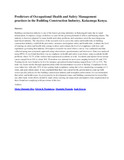| dc.contributor.author | Oloo, Micky Olutende | |
| dc.contributor.author | Wamukoya, Edwin K | |
| dc.contributor.author | Wanzala, Maximila | |
| dc.contributor.author | Kweyu, Issah | |
| dc.date.accessioned | 2022-01-10T09:32:12Z | |
| dc.date.available | 2022-01-10T09:32:12Z | |
| dc.date.issued | 2020-04 | |
| dc.identifier.uri | https://doi.org/10.9790/1959-1002044357 | |
| dc.identifier.uri | https://www.researchgate.net/publication/350588299_Predictors_of_Occupational_Health_and_Safety_Management_practices_in_the_Building_Construction_Industry_Kakamega_Kenya | |
| dc.identifier.uri | http://ir-library.mmust.ac.ke:8080/xmlui/handle/123456789/1996 | |
| dc.description.abstract | Building construction industry is one of the fastest growing industries in KakamegaCounty due to rapid urbanization. It employs a large workforce to cater for the growing demand of offices and housing estates. The industry is however plagued by many health and safety problems and sometimes rated the most dangerous land-based industry. The objectives of the research were to assess the safety and health risks in building construction industry, establish the preventive measures used against safety and health risks, evaluate the level of training on safety and health risks among workers and evaluate the level of compliance with laws and regulations governing that industry. Descriptive research was used where a survey was conducted and data collected using non-systematic approach using observations, questionnaires and interviews. Data was analyzed using SPSS. It was found that there was no emphasis on health and safety issues hence many accidents health problems where 70.7% of the workers had experienced accidents at work. Accidents and injuries from various causes ranged from 10% to about 56%. Protection was minimal in most cases ranging between 0% and 33%. Training levels were found to be low for instance specialized formal training ranged from 3.2% to 33%. The trade was learnt mostly through apprenticeship while documentation was poor or lacking. Compliance levels were rather low with only 25% of sites getting high compliance rating due to low monitoring averaging at 2.3 visits, and poor enforcement. It was concluded that there was a need for the government to come up with sector-specific policies for the building construction industry and strengthen enforcement. It is recommended that safety and health issues be given priority in development issues and building construction be treated like any other trade. Joint efforts should be made when carrying out inspections and punitive fines implemented on those found not complying with provisions of the law. | en_US |
| dc.language.iso | en | en_US |
| dc.publisher | IOSR Journal of Nursing and Health Science (IOSR-JNHS), | en_US |
| dc.subject | Predictors, Occupational, Health, Safety, Management, practices , Building, Construction, Industry | en_US |
| dc.title | Predictors of Occupational Health and Safety Management practices in the Building Construction Industry, Kakamega Kenya | en_US |
| dc.type | Article | en_US |

